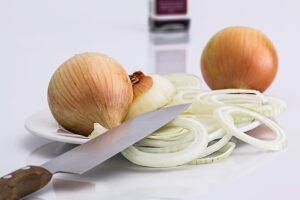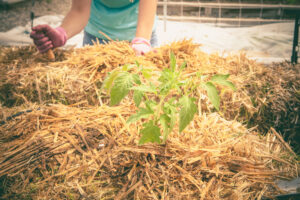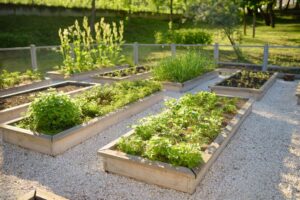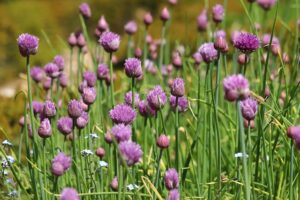
Introduction:
Onions, with their versatile flavors and culinary importance, are a staple in many kitchens. Whether you’re a gardening enthusiast or a seasoned grower, choosing the right method for cultivating onions can significantly impact your harvest. In this comprehensive guide, we will explore three popular methods for growing onions: straw bales, raised beds, and ground planting. We’ll cover the unique characteristics, benefits, potential drawbacks, and specific techniques for each method. Additionally, we’ll discuss fertilization practices to begin mastering growing onions. Let’s dive in!
Straw Bale Onion Cultivation

Straw bale gardening has gained popularity due to its simplicity and effectiveness. When it comes to growing onions, straw bales offer several advantages:
- Improved Drainage: Straw bales provide excellent drainage, preventing onion rot or disease caused by excessive moisture.
- Weed Suppression: The straw acts as a natural weed barrier, reducing competition for nutrients and minimizing the need for manual weeding.
- Temperature Control: Straw bales retain heat, promoting early onion growth and extending the growing season in cooler climates.
- Space Optimization: Onions can be directly planted into the bales, making this method suitable for those with limited space.
Conditioning Your Straw Bales:
You can’t just stick seeds or plants into a straw bale. There is some prep work that needs to be done to get them ready.
- Choose tightly bound straw bales free from mold or signs of decay.
- Place the bales in a sunny location receiving at least six hours of sunlight daily.
- Water the bales thoroughly to initiate the decomposition process.
This video shows in more detail how to condition your bales: https://www.youtube.com/watch?v=gPFW2bonbyA
Aging the Straw Bales:
- Over 10-14 days, condition the straw bales to create a favorable growing environment for onions.
- Water the bales daily to maintain moisture and promote decomposition.
- On day three, add a nitrogen-rich fertilizer (such as blood meal or urea) to speed up decomposition.
- Continue watering and fertilizing daily throughout the conditioning phase.
Planting Onions in Straw Bales:
- Once the straw bales are sufficiently decomposed and have a soft, crumbly texture, create small pockets or furrows in the top surface. You can put compost or soil into these pockets and you are ready to plant.
- Place onion sets or seedlings into the pockets, ensuring the roots are covered and the bulb is exposed.
- Space the onion sets or seedlings according to the recommended spacing for the specific onion variety.
- Water the bales regularly to maintain moist but not waterlogged growing conditions.
Raised Bed Onion Cultivation:

Raised beds provide optimal growing conditions for onions. Consider the following advantages:
a. Soil Quality Control: Raised beds allow complete control over soil composition, ensuring optimal nutrient levels and drainage.
b. Reduced Weeding: Elevated beds minimize weed intrusion, resulting in reduced competition for resources and less manual weeding.
c. Improved Aeration: Loose, well-draining soil in raised beds promotes proper root development, preventing issues like bulb rot.
d. Easier Maintenance: The compact size of raised beds offers easy access for tasks like watering, fertilizing, and harvesting.
e. Soil Mix Recipe for Raised Beds:
- Prepare a soil mix by combining equal parts garden soil and compost for nutrient-rich growth.
- Incorporate organic matter (well-rotted manure or composted leaves) to improve soil structure and water retention.
- Add perlite or vermiculite to improve drainage and prevent soil compaction.
- Consider using a balanced organic fertilizer to provide essential nutrients throughout the growing season.
- Thoroughly mix the ingredients to ensure a homogenous blend.
f. Planting Onions in Raised Beds:
- Prepare the raised bed by removing weeds and debris and amending the soil with compost or organic matter.
- Plant onion sets or seedlings in rows, following the recommended spacing for the specific onion variety.
- Water the raised bed regularly, keeping the soil consistently moist but not waterlogged.
- Consider side-dressing with a nitrogen-rich fertilizer as the onions grow to promote foliage growth and bulb development.
Planting onions in the Ground

Planting onions in the ground is a traditional and cost-effective method for growing onions. Consider the following advantages:
a. Natural Nutrient Availability: The soil in the ground naturally provides nutrients, minimizing the need for extensive fertilization.
b. Cost-Effective: Ground planting requires minimal investment in materials, making it a budget-friendly option.
c. Easy Access to Nutrients: The roots of ground-planted onions can access nutrients from the surrounding soil more easily.
d. Planting Onions in the Ground:
- Select a sunny location with well-drained soil for ground planting onions.
- Prepare the soil by removing weeds and debris and loosening it to a depth of 6-8 inches.
- Plant onion sets or seedlings in rows, following the recommended spacing for the specific onion variety.
- Water the ground-planted onions regularly, ensuring the soil stays consistently moist.
Onion Fertilization
- Before planting onion sets or seedlings, apply a balanced organic fertilizer with an N-P-K ratio of 10-10-10 or similar.
- Follow the fertilizer manufacturer’s instructions for proper application rates.
- Consider side-dressing with a nitrogen-rich fertilizer as the onions grow to support foliage growth and bulb development.
Onion Pest and Diseases
Onions, like any other agricultural crop, can be susceptible to various pests and diseases that can hinder their growth and overall yield. Two commonly encountered onion pests are thrips and onion maggots. Thrips are tiny insects that cause damage by sucking sap from the plant, whereas onion maggots burrow into the onion, causing damage to the bulbs.
In terms of diseases, onions can be affected by bacterial and fungal infections like black mold, pink root, and onion smudge. Black mold is identified by dark, sunken lesions on the bulb’s surface, pink root is characterized by a pink discoloration of the roots, and onion smudge presents as black, powdery spots on the onion’s skin.
For treatment, integrated pest management (IPM) is advised. This includes a combination of cultural practices, biological control, and targeted pesticide use. Cultural practices such as crop rotation and the use of disease-free seeds can help prevent disease. Biological control involves introducing beneficial organisms that naturally control pests. Finally, pesticides should be used judiciously, targeting specific pests or diseases, to minimize potential harm to beneficial organisms and the environment.
Conclusion:
Growing onions can be a rewarding and enjoyable experience. Each planting method – straw bales, raised beds, and ground planting – offers unique advantages. Choose the method that suits your space, resources, and gardening goals. Proper fertilization, whether with nitrogen-rich additives during straw bale conditioning, a balanced organic fertilizer for raised beds, or minimal fertilization in ground planting, ensures healthy onion growth and a bountiful harvest. Experiment, learn from your experiences, and savor the satisfaction of homegrown onions in your culinary creations.
For more on gardening check here.
For DIY garden soil mix recipes click here
For more on straw bale gardening click here.

